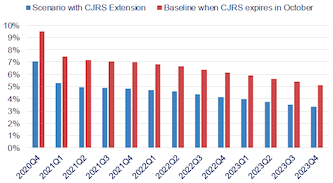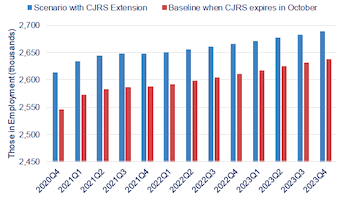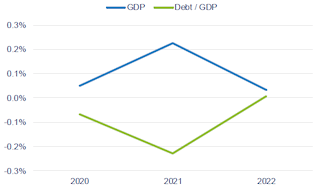Coronavirus (COVID-19) - extending the Coronavirus Job Retention Scheme: analysis
Paper exploring the costs and benefits of extending the Coronavirus Job Retention Scheme on a temporary basis. Such an extension could reduce unemployment in Scotland by 61,000 through the first half of 2021, at a cost of around £850 million.
Modelling the Impact of Extending the CJRS
Background
The National Institute of Economic and Social Research (NIESR) has undertaken economic modelling of extending the CJRS in the UK. They argue that “.. the planned closure of the CJRS seems to be a mistake, motivated by an understandable desire to limit spending. The furlough scheme was intended by the Chancellor to be a bridge through the crisis and there is a risk that it is coming to an end prematurely.”[2]
NIESR provide some quantification of the costs and benefits of extending the CJRS for an additional eight months into the middle of 2021. In this scenario, the direct cost of extending the scheme in the UK would amount to around £10 billion
They conclude “...Unemployment would have stayed lower had the government extended the furlough scheme beyond the end of October. This would have been a relatively inexpensive measure, and by preventing a rise in long-term unemployment might have paid for itself.”[3]
Scenario modelling
We have replicated the NIESR modelling on the costs and benefits of a temporary extension of CJRS for an additional 8 months.
The economic modelling uses the Scottish Government Global Econometric Model. The model compares the “baseline” situation (no extension to CJRS) with a scenario where the CJRS is extended until the end of June 2021. The scenario is modelled as follows:
- A direct increase in employment in Scotland and the rest of the UK for 2020 Q4 until 2021 Q2.
- This is associated with an increase in government spending in 2020 and 2021.
- The model then incorporates spillovers from these interventions, which in the longer term have a greater impact than the initial intervention and raise levels of employment persistently across the scenario horizon until 2023.
The costs of these changes in unemployment and employment are then calculated as follows:
- The direct costs of extending the scheme (paying the wages of furloughed workers) are offset to a degree by the taxes that are paid by furloughed workers and by avoiding having to pay unemployment benefits for these workers.
- NIESR estimate that the total cost is £2,000 per job, per month and that 25% of the direct costs of the extension is offset from additional tax revenue or forgone social security expenditure. We use the same assumptions.
The benefits of extending the CJRS are as follows:
- The immediate economic benefits of extension come from higher levels of economic activity. The income of furloughed workers generates higher consumer spending than would otherwise be the case and has the wider effect of supporting employment elsewhere in the economy.
- Over time a further potential benefit is that the extension can help to keep people in work and prevent long term unemployment and the unnecessary labour market “scarring” such as from skill depletion or avoiding job seekers becoming discouraged and economically inactive. This effect is more difficult to quantify but is an important part of the equation.
Labour Market Results of a Temporary CJRS extension
The impact of the extension on unemployment is to reduce the rate of unemployment in Scotland by 2.5 percentage points in Q4 2020 (to 7% instead of 9.5%) and keep the rate of unemployment lower than it otherwise would have been without the extension to the end of 2023 (see chart 4 below).
This is the equivalent of reducing the number of unemployed people in Scotland by 61,000 through the first half of next year.

Source: Scottish Government Global Econometric Model (SGGEM)
The fall in the unemployment rate is driven by a persistently higher level of employment relative to the baseline when the CJRS expires in October. Effectively the temporary extension means that higher initial levels of employment, supports additional consumer spending in the economy, which in turn supports additional levels of employment and activity that otherwise would have been lost.
As a result, by the end of 2023 the level of employment is 1.9% higher than if the CJRS was wound down in October. This is the equivalent of around 50,000 jobs by the end of 2023 which are protected by the as a result of the extension as can be seen in Chart 5
Even though the extension of the CJRS is only temporary, there is evidence it can have a persistent, positive impact on the labour market and help to prevent unnecessarily higher levels of unemployment over the next few years.

Source: Scottish Government Global Econometric Model (SGGEM)
Costs and benefits
Based on the latest evidence and in a similar proportion to assumptions made by NIESR we assume that around 102,000 people are still on the furlough scheme as of the end of October and remain so in November and December as the scheme is extended (at a cost of approximately £300 million). We then assume that this falls to 61,000 people across January to June (at a cost of approximately £550 million), resulting in a total cost of approximately £850 million for the 8 month extension. On a per capita basis, this is very similar to the NIESR estimate of £10 billion for the UK as a whole.
Although the costs of the extension are estimated to add to the total UK debt, the modelling finds that the increase in domestic demand from the extension of the scheme boosts GDP in the short term by more such that the debt to GDP ratio falls (up to 2021). Wider economic benefits from the extension mean that it could pay for itself, increasing GDP and potentially lowering debt as a share of GDP over 2020 and 2021. In this sense the extension “pays for itself” in the short term.

Source: Scottish Government Global Econometric Model (SGGEM)
Value for Money – CJRS Extension versus the Job Retention Bonus Scheme
Another consideration is how the £10 billion cost of extending the CJRS in the UK compares to the costs of the UK job retention bonus scheme announced in the Summer Economic Update,[4] which has a similar cost if all employers had taken up the scheme. This scheme provides a one-off payment to employers of £1,000 for every employee who they previously claimed for under the scheme, and who remains continuously employed through to 31 January 2021. The scheme has been criticised as being less targeted than an extension of the CJRS, and indeed some large employers have already indicated that they will not take up the bonus.[5] They cite a risk that money will be paid to cover jobs which weren’t actually at risk and hence, with similar concerns being raised by the Chief Executive of HMRC.[6] There is therefore a reasonable case to be made that an extension of the CJRS could be more effective, and potentially better value for money, at saving jobs most at risk and supporting the wider labour market.
Conclusion
As we deal with the on-going health response to the pandemic, economic uncertainty remains high particularly for sectors of that economy that have been disproportionally impacted. The support by Government during the early period has been substantial but risks remain elevated for the business base and for the labour market in Scotland.
Our analysis suggests that a temporary extension of the CJRS could reduce unemployment in Scotland by 61,000 through the first half of next year. We estimate that the direct cost of extending CJRS for eight months for Scotland is around £850 million. The equivalent cost at UK level is £10 billion and would represent a modest cost in comparison to the £192 billion direct fiscal stimulus from the UK government to date and in comparison to the potential cost of the Job Retention Bonus Scheme.
The analysis has focused on one variant an extension of the CJRS could take, that is, a temporary extension of CJRS. There are other options for extending the scheme, as highlighted by the analysis of wage subsidy schemes in other countries, including targeted extensions for hard hit sectors.
With Covid-19 cases on the rise, it may prove impossible for certain sectors to resume economic activity in a way that is economically viable before the CJRS ends in October 2020. Many of these businesses will have a viable long-term future but only if they survive this immediate period. The pandemic has had a material impact on sectors of the economy which has induced structural change to business models. We know many businesses are also operating at reduced capacity levels and dealing with the uncertainty relating to their market given potential COVID restrictions.
Given the uncertainty relating to the pandemic, a temporary extension of the CJRS until next year will provide a degree of certainty and flexibility for business in dealing with the pandemic. It will keep people in jobs while sectors of the economy currently unable to fully open recover. It will avoid the tipping point of a large increase in unemployment at a time when the economy remains substantially below its operating level and we are dealing potentially with a second recurrence of the virus over the winter months.
Although it will require fiscal support it has the potential to provide to sustained economic benefits at a relatively small cost and arguably at better value for money than the Job Retention Bonus Scheme. Given the importance of government support at the outset of this crisis, managing the exit to this scheme is important. Other countries have expanded their schemes to some extent reflecting the risks to the economy and jobs.
Finally, if managed well, wider economic benefits from the extension mean that it could pay for itself, increasing GDP and potentially lowering debt as a share of economic output over 2020 and 2021.
Contact
Email: OCEABusiness@gov.scot
There is a problem
Thanks for your feedback